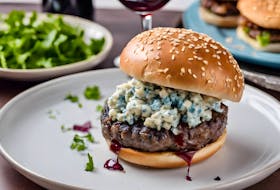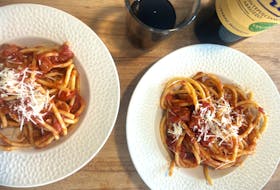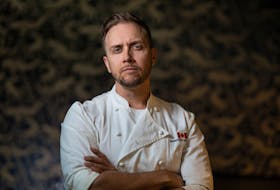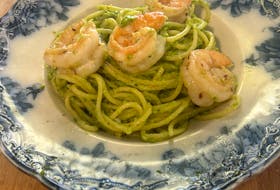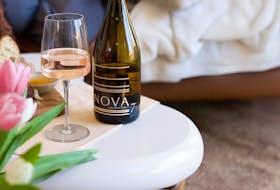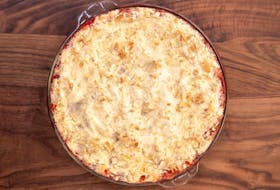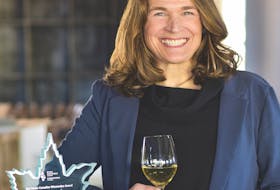Our cookbook of the week is Tawâw: Progressive Indigenous Cuisine by Enoch Cree chef Shane M. Chartrand with Jennifer Cockrall-King. To try a recipe from the book, check out: Beet-cured salmon with chanterelles and saskatoon sauce , braised venison shanks with mossberry black garlic glaze and herbed wheat berries , and kombu seaweed soup with pheasant .
A stockpot steams on Nisga’a Elder Winnie Doolan’s stovetop. Within it, cubes of seal meat, carrot, celery, onion and potato simmer, seasoned simply with salt and pepper. In Gingolx, an Indigenous fishing village in Northern B.C.’s Nass River valley, the sea has provided for generations: Locals harvest crab, halibut, salmon, shellfish and snapper as well as seal, which they use to the fullest. Enoch Cree chef Shane M. Chartrand follows Doolan’s instruction as he helps prepare the seal meat stew, the recipe for which she learned from her mother: “Anything we do is handed down from my parents.”
The cooking session took place when Chartrand was in Prince Rupert filming an episode of Red Chef Revival , a six-part docuseries focusing on modern Indigenous cuisines. “We’re not taught to do things like this in culinary school,” he tells Doolan of the boiling method. “It means something.” As she separates the stew, serving the broth in a small bowl, the meat and vegetables on a plate, he makes a sure pronouncement: “That is an Indigenous dinner.”
Chartrand recounts the experience in a phone interview, emphasizing the sustainability of seal meat and the immense importance it holds for the coastal community, simultaneously highlighting the chasm between the meal he had in Gingolx and the “carnival food” sometimes associated with Indigenous cuisines. “I’m not against fry bread. I’m not against Indian tacos. I can’t be against it when it’s been a part of our culture for so, so, so long,” he says. “Who am I to tell the entire country of Canada that bannock, fry bread and Indian tacos are not us? I just think we need to dig way, way, way deeper … There’s a lot more to life and there’s a lot more to this land.”
For the past 15 years, after learning he was originally from the Enoch Cree Nation in central Alberta, Chartrand has made it his mission to not just learn more about his home nation but others as well. This undertaking, accompanied by essays and more than 75 recipes, provided the inspiration for his debut cookbook, Tawâw: Progressive Indigenous Cuisine (House of Anansi, 2019; with Jennifer Cockrall-King).
At a year and a half, Chartrand was taken from his Plains Cree parents and put into foster care during the Sixties Scoop, which began in the late 1950s and continued into the ’80s. Adopted by a Métis father and Mi’kmaw-British mother when he was seven years old, he grew up close to the land on an Alberta acreage, unaware of which nation he was from until he met his biological family at 29. Charting his youth in the book — hunting trips with his dad, Dennis, and helping out on the family farm — as well as his culinary career was important to him: “People don’t realize because I’m all tattooed and whatever, but I am truly a farm kid deep down and I hope this book represents all those elements.”
Now executive chef at SC Restaurant at River Cree Resort & Casino in Enoch, Alta., Chartrand has competed on Iron Chef Canada and Chopped Canada, and participated in Cook It Raw, a gathering of international chefs. In Tawâw , he shares recipes for home cooks and chefs requiring a range of skill level and ambition: A collection of competition dishes, including the striking and Gold Medal Plates award-winning “War Paint” (quail and wheat berries on red pepper sauce), a photo of which is on the book’s cover; items from restaurant menus and events; and personal favourites drawing on his time spent cooking with others.
He describes his style of cooking, which was informed by an early passion for the “spirituality and beauty” of Japanese food, as “progressive”; dynamic, continually pushing onward. “It’s always moving, whether that be talking about me maybe reinventing some old Indigenous dishes or taking what I’ve learned from these nations and building dishes that I like,” he says. “There are so many ways of looking at things but, to me, progressive means ever-changing.”
Despite the close proximity of reserves to cities and towns across the country, few Canadians have ever spent time on one (roughly two-thirds have no contact with Indigenous Peoples and nearly 40 per cent have never visited a reserve, according to a 2018 survey). As a result of this divide, knowledge of Indigenous cultures is limited, says Chartrand. “There are so many questions that people have for Indigenous people. There are so many people out there that are surrounded by reserves — everyone lives by a reserve. Most people who live close to a reserve know nothing about it … We all have different protocols, and we all have different food symposiums and belief systems,” he adds, saying his intent with the book was to give readers “a small little glimpse of who we are as people … I’d have to write ten of these books to even come close.”
The meaning of tawâw (a Cree word pronounced ta-WOW) — there is room, you are welcome — is a further expression of this sentiment, says Chartrand: “You are welcome to be with me any time. My home is yours. My friendship is yours. My culture is yours.”
Copyright Postmedia Network Inc., 2019

